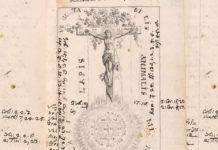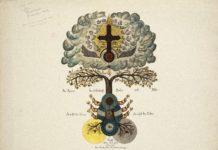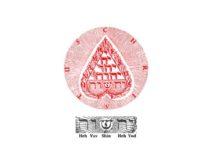Willy Schrödter claimed in his Rosicrucian Notebook that Madam Blavatsky was Alois Mailander’s student. How did this story come about? In this post we share a 1941 letter, which is the real source of that information and examine how reliable the story is.
In 1941 Alfred Edler-Müller wrote a letter, which is preserved in the archives of Lambert Binder, Vienna. It makes some statements about Alois Mailänder and his teacher, Prestel, which are quite astonishing and seemingly ground-breaking. Alfred Binder was a friend of the famous writer Gustav Meyrink and had cooperated with him[i]. Lambert Binder had collected a lot of occult texts and had compiled a rich Meyrink archive.[ii]
The letter reads:
Alfred MÜLLER-EDLER to Peter KLIMA
Hamburg, 5 October 1941
Now, in conclusion, a few words about Mailänder.
Gustav Meyrink (1868-1932) told me approximately the following at the time:
I had a guru from the 23-32nd year, i.e., a simple, enlightened journeyman weaver, to whom even the Blavatsky (1831-91) came on pilgrimage with the Indian Babij. A man á la Jakob Böhme (1575-1624).
I owe him an infinite debt. He knew a wandering, old, enigmatic man, apparently a Rosicrucian, who was a master carpenter and was called Prestel, who could produce magical phantasmagoria, etc. Dr. med. Franz Hartmann (1838-1912), who was my classmate, got 9/10 of his “knowledge” from these sources. Prestel possessed a bottle with a grey salt. It was the unfinished elixir of life, he said. He always put it near the warm kitchen stove. One day there appeared in the bottle – my “guide” (not to be confused with the true spiritual guide), saw it for himself! – a real blue snake. Prestel said: I must die. Died too. The elixir remained unfinished.
G.M. later told me the following about this story: Prestel occasionally said that an adept of the Middle Ages had buried a bottle with red powder (!) near the church “Heilig-Kreuz” at (here GM also names the place). The fact is that Mailänder himself saw that a miracle happened in winter near the church: Around the church in 5 places quantities of “blood” came out of the ground through the snow. Mailänder never lied and was a keen, critical observer. Many others saw it too.
About Mailänder compare
1) Franz DORNSEIFF, “The Alphabet in Mysticism and Magic”, Berlin 1922 (p. 153/153)
2) Karl Weinfurter, “Der brennende Busch”, Lorch (Wittig), 1930 (p.206/207)
Archive: Reg. Rat Ing. Lambert Binder
A-1180 Vienna Theresiengasse 28
Thanks to Roger Heil, for providing this letter to Samuel Robinson and Erik Dilloo-Heidger during their visit to Dreiech to see Mailander’s home in 2022.
Now there are quite a few problems with this letter.
For the first: this is written down in 1941, almost ten years after Meyrink´s death. Of a friend that remembers things, as he himself says, “approximately.” We all know that memory is no reliable source. Ask any policeman or lawyer about the quite diverging stories so-called eyewitnesses tell! And in addition, this is a second-hand memory.
Now it states that Blavatsky came to Mailänder together with Babij. This Babij must be Babaji, the one who accompanied Mme. Blavatsky to Europe in 1885, but turned against her at the end this year and caused much trouble in theosophical circles, especially with the Gebhard family.[iii] That Mailänder and Blavatsky met somewhere in Germany in 1885, could be the case, but it does not imply any teacher-disciple relationship! More to that in a second post.
What he tells about Prestel is a bit mixed. We know that Hartmann wrote about Prestel in his 1888, in his “Magic Black and White”[iv]:
There lived about ten years ago a person whose name was Prestel, within a short distance of the town where we are now writing, who was a reputed Rosicrucian and Alchemist. We personally knew this man and are well acquainted with two of his still living disciples. This man was generally known as an eccentric and mysterious person. He possessed great powers of projecting the images formed in his own mind upon the minds of others, so that they believed to see things which, however, had no objective existence. …
So, there we have the source for some of the statements in the letter, which is Franz Hartmann himself.
But we have no possibility of confirming or disconfirming the story of the elixir and how the snake predicted is Prestel´s death, we just know that Wilhelm Hübbe-Schleiden had an entry in his notebook of 1885 [v]:
Prestel (Farmer) died in 1871 in Heilig[en]kreuz at Kempten was a Rosicrucian.
But to the story about the miracle at Heiligkreuz in Allgäu we can make some quite precise remarks.
For the first: Müller-Edler does not quite remember where this church lies, he says only that Meyrink gave the exact place.
But we know the following about the blood miracle at Heiligkreuz in Kempten (the Church of the Holy Cross):
The miracle revealed itself in 1691 when, according to legend, on the eve of the Holy Apostle Jacob, one Elisabeth Wegerin was busy turning hay in the square where the church stands today. Suddenly she saw the blood splatter half a shoe high in five places on the surface of a small oval tablecloth, which lasted half an hour. These five fountains of blood have been associated with the five wounds of Christ on the cross. Several eyewitnesses confirmed the testimony by taking an oath and two rakes kept in the church are said to have shown the blood stains for a long time.
So yes: this was witnessed by many, according to legend, but this happened in the summer, as the turning of the hay indicates.
But there is reported another miracle nearby, at the chapel of Gschnaidt in Altusried. A painting in that chapel commemorates:
Here in Geschneite, one afternoon in March 1845 from one to three o’clock, in a four to five inches deep snow, a farmer and a merchant observed an incalculable imprinted number of different writings and signs of all kinds, without any connection or context. Neither human footsteps nor other traces of a living creature could be discovered. The interpretation of this phenomenon will not be difficult for the observer of our time.[vi]
There is where the winter and the snow come in. It is quite obvious that Meyrink (or even Müller-Edler) had mixed up the two miracles, which they heard retold from a place they did not know too well and made one miracle out of two.
But did Mailänder, “who never told any lies”, really see this? In 1691 he was definitely not around, being born in 1843. In 1845 he was two years old and on top of all, did not live at Kempten at the time. He came to Kempten ten years old.
So how come? He must have talked about these two miracles to his students, and Meyrink misunderstood this as something Mailänder had seen and experienced himself. And Meyrink gave this version of the story to his friends. So that is an example how rumours arise and how one can make a mountain out of a molehill, or how one can blow everything out of proportion.
But the story goes on. Willy Schrödter must have seen this letter and used it as his source, but without giving an exact reference it or where he got this from:
“This man Mailänder,” said Meyrink, stressing that the latter had never told a lie, “saw one winter’s day… near the Church of the Holy Cross, the snow stained as red as blood in a certain place, and declared that an adept of the Middle Ages (Paracelsus, 1493—1541) had buried some of the red tincture and that the red coloration in the snow had been caused by emanations from this tincture.” The “blood” was impressed at five places around the Church and many others saw it besides Mailänder.
Now, Prestel was one of those who came to Germany. He was a nomadic and mysterious old man. He was a master joiner by profession, but could produce magical phantasmagoria, etc. In his possession there was a bottle containing a grey salt. According to him, it was the unfinished elixir of life. He always kept it near the warm kitchen stove. One day a real blue serpent appeared in the bottle and Prestel said, “I am going to die.” He did die, too. The elixir was never perfected. After his death, it was passed on to a certain Gabele in Darmstadt who became his brother-in-law and, today, this unfinished product is in one of the cities of Southern Germany.[vii]
Here we find an almost exact copy of that story given in the letter of 1941 but adding some juicy details or additional “facts” (like Gabele becoming the brother-in-law of Prestel. As we know, he was Mailänder’s brother-in-law). Schrödter is also the one who calls Blavatsky a student of Mailänder.
And now Schrödter’s record of the story lives on, as if it was a historical fact. One should never trust hearsay and check every rumour. Because rumours tend to live their own lives, making an elephant out of a fly.
Christine Eike
[i] https://de.wikipedia.org/wiki/Alfred_M%C3%BCller-Edler
[ii] https://parapsychologie.info/binder/index.html
[iii] https://theosophy.wiki/en/Babaji
[iv] Franz Hartmann: Magic, Black & White, 1888 footnote on page 216 English edition. 1888 German edition page 235.
[v] Cod_Ms_Huebbe-Schleiden_1012_4. Page 20. Library in Göttingen. Heiligkreuz is spelt as Heiligenkreuz
[vi] Translation taken from Samuel Robinson: Alois Mailander: A Rosicrucian Remembered, 2021, page 24
[vii] Willy Schrödter: A Rosicrucian Notebook, page 132










